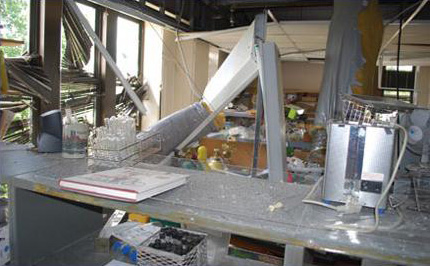Last Revised: April 20, 2018
An explosion caused by hydrogen gas used with an anaerobic chamber in a University of Missouri biochemistry research lab on Monday injured four people and destroyed the laboratory. A report from Chemical & Engineering News summarizes the incident. Four people were injured in the explosion. One person is hospitalized. Damages are expected to exceed $750,000.
Anaerobic chambers are used to work with oxygen sensitive organisms. The anaerobic chambers contain various concentrations of hydrogen, carbon dioxide and nitrogen. A catalyst system scavenges trace amounts of oxygen from the chamber. Because the concentration of hydrogen in an anaerobic chamber may exceed the lower explosive limit of 4%, extreme care must be taken to prevent oxygen from entering the chamber.
This was not the first anaerobic chamber explosion to occur in a research lab. Explosions have occurred due to the inadvertent admission of air into a chamber during maintenance and due to the use of a mixture of 95% hydrogen/5% nitrogen instead of 95% nitrogen and 5% hydrogen.

Lessons Learned
-
Use non-flammable mixtures of hydrogen (4%) where possible.
-
Always purchase the smallest cylinder of flammable gas needed. Avoid purchasing full sized cylinders.
-
Verify the identity of gases before use. It is not uncommon to received incorrect gas mixtures.
-
On start up flush chambers with nitrogen gas instead of hydrogen mixtures.
-
Leak test the chamber on start up.
-
Know how to purge the air lock on your anaerobic chamber. Improper use of the air lock can admit oxygen into the chamber.
-
Monitor the oxygen concentration in the chamber. Replace oxygen indicators as recommended by the manufacturer.